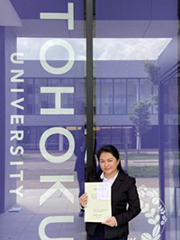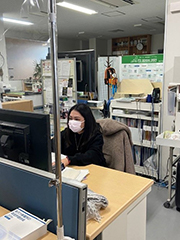April 1, 2021
Ms. Jehan Fe S. PANTI, The Philippines
Tohoku University, School of Engineering (M.Eng)
Designation in home country: Philippine Atmospheric, Geophysical and Astronomical Services Administration (PAGASA-DOST), Weather Specialist
Disaster Risk Reduction (DRR) Leaders Capacity Development for the Sendai Framework Implementation is a higher degree program tailored to the professionals at the government DRR institutions in JICA partner countries. It is part of the JICA Development Studies Program (JICA-DSP) - the program which invites future leaders in different fields from JICA's partner countries to Japan. Since its inception in 2018, DRR Leaders Capacity Development for the Sendai Framework Implementation has received ten scholars. Amongst them is Ms. Jehan Fe S. Panti from the Philippines, who is enrolled in her second year of Masters of Engineering course at Tohoku University. We have conducted an interview to get to know more about her.

Jehan at Tohoku university
[Q1] What do you study mainly in graduate school?
I am an M2 student in the Tsunami Engineering Laboratory, Graduate School of Engineering, Tohoku University. The focus of my graduate studies is disaster science. I chose this field to contribute to increasing people's awareness and preparedness towards a collective community disaster risk reduction.
[Q2] Tell us about your master's thesis project. We are interested in learning your research topic/question and objectives, the methods you are applying, and why you chose this research topic.
My master's thesis project studies the impact of disaster information during flood disasters. My primary motivation is to understand what triggers early evacuation and the effectiveness of broadcast media in conveying disaster situations.
Around the time I arrived in Japan last October 2019, Typhoon Hagibis hit the country. It is considered one of the strongest typhoons to strike Japan in recent years and brought record-breaking rainfall in several areas. Given my meteorology background, this flood disaster became an interesting topic for my research. The main research questions are: how does media affect the imaging and situation awareness of those in the affected areas, and how does the use of disaster information affect the evacuation behavior of residents.
For the first question, a content analysis was performed on the coverage by NHK General TV during 11-14 October 2019. I created a database of the disaster information types and display times of areas mentioned during the broadcast period. This exposure frequency is compared with the actual damages reported after the disaster to identify a gap between the areas broadcasted and the damage status.
For the second question, data from interview surveys conducted for flood survivors in Osaki, Osato, and Marumori in Miyagi prefecture were used to characterize the evacuation behavior during the typhoon. These areas suffered the greatest material damages in Miyagi prefecture; however, a difference was observed when Osaki and Osato remained casualty-free while Marumori recorded ten casualties. Regression analysis was performed to identify the factors that influenced evacuation decisions and which information sources contributed to early evacuations.
Eventually, I want to learn how disaster information affects people's perception and behavior during disasters and suggest effective measures to raise people's awareness of the importance of early evacuation.
[Q3] What did you study in your undergraduate course?
I was a Meteorology student in my undergraduate years in the Philippines. Our course focuses on learning atmospheric sciences and its applications in weather and climate studies. In addition to studying the theories related to meteorology, we were also exposed to the operations and responsibilities of working for the Philippine weather agency - PAGASA.
During that time, my research study was about the meteorological indicators and characteristics of the onset of the Southwest monsoon in the Philippines. This phenomenon is significant because it signals the start of the wet season in most parts of the country.

Jehan at university lab
[Q4] Why did you become interested in meteorology?
I became interested in meteorology because growing up in my hometown, Albay; we were always in the path of tropical cyclones every year. Having these experiences and vivid memories of past storms, I want to understand the mechanisms of these natural phenomena and relate them with the preparedness and resilience of the people in our area. With climate change, we start to observe differences in the tracks and intensities of cyclones that affect the country, wherein places previously impervious to the path of storms are becoming affected more frequently and intensely. Equipped with an understanding of the environment and personal experiences, I aspire to share my learnings with the community with the work I do as part of the meteorological agency.
[Q5] How do you plan to apply what you have learned in Japan in your future work?
In coming to Japan, I have been exposed to the locals' culture and way of life. I witnessed several natural hazards affect the country, including storms, floods, and even earthquakes. During such times, I have seen how Japanese authorities manage small and wide-scale disasters and the people's behavior towards them. It is interesting to see the similarities and contrasts in behavior between Japan and my country and adapt effective practices in disaster management when I come back. I previously had an idea about the importance of disaster management in Japanese people's lives but coming here and seeing it firsthand gave me a deeper appreciation and understanding.
[Q6] What kind of career are you going to pursue after returning to the Philippines?
Before coming to Japan, I was a researcher in PAGASA-DOST. My work includes doing research related to tropical cyclone events that affect the Philippines and working towards improving the weather forecasting capabilities of the agency. After finishing my studies, I will return to my original post and apply the learnings I acquired during my stay in Japan.
[Q7] We are curious to know how you've been adapting and coping with life in general in Japan. Would you please share any unique stories/experiences you've gone through during your time in Japan? (eg. difficulties you encountered in your study/life/culture, something that surprised you, interaction with the local people, etc.)
At first, it was a challenge to live in a foreign country and being far away from my loved ones. But technology has made it more accessible to reach family in different parts of the world, so I still felt closer to them despite the physical distance. I found that people here are generally friendly and respectful, which I really appreciate. The respect for time, especially on public transportations and on anything scheduled generally, was a breath of fresh air compared to my experiences in the Philippines. The professors, students, and staff in the university and dormitory were nice and accommodating, making it easier for me to adapt to my new environment. Although I, until now, could not speak or write Japanese, I still manage to work my way around daily tasks with the help of basic Japanese phrases and Google translate - with locals also being very considerate and accommodating.
I had a unique experience when my research advisor, Sato Shosuke sensei, brought me along to conduct an interview survey to residents of Osato in Miyagi prefecture. After one interview, the respondent offered us what seemed to be a "sweet" that they had made themselves. They were very nice and offered one to each of us in the team. It looked like chocolate to me, and I could not ask anyone to verify it at the moment. The residents were very nice, and I saw that my companions ate it in one go, so I followed through. I recognized the taste only after I bit into it - it was raw garlic and soy sauce! After some googling, it appears that it is a type of pickle, specifically soy garlic pickle called ninniku zuke. I still ate it, I do love garlic, but it was rather surprising and intriguing to be offered such kind of food, given that I was very far off from my guess. What struck me from this experience was the hospitality and generosity that the residents showed us despite having just met us then and knowing that I was a foreigner.
During the first few months of my stay here, I was not able to explore different areas around Sendai - part of it was my nervousness to roam around alone (I know it is safe to walk around in Japan), and part of it was my preference to stay indoors (I sometimes get anxious in crowded places). When the pandemic started, it made it more difficult to travel and go around in general - so my plans to visit other places did not come true. But even after I finish my studies, I think I will come back to Japan with friends and family (when it is safer) to explore and visit other places I have not been to.
Interviewer: Takeshi Okuma
Global Environment Department, Disaster Risk Reduction Team 2




scroll